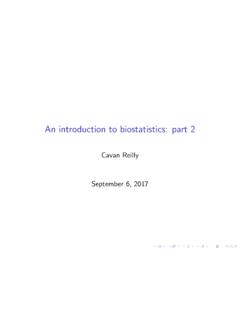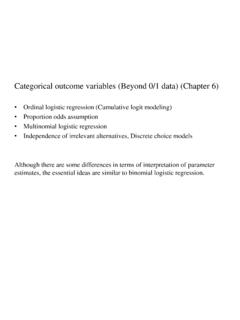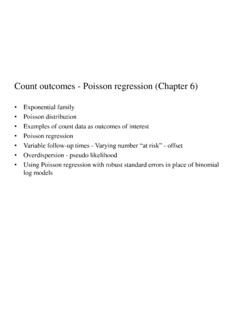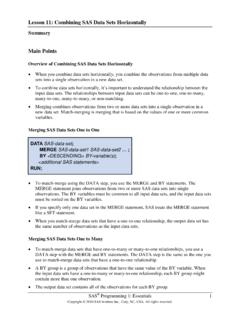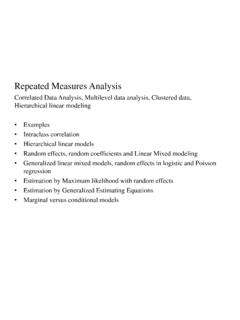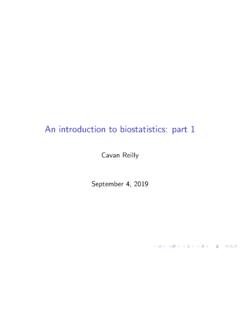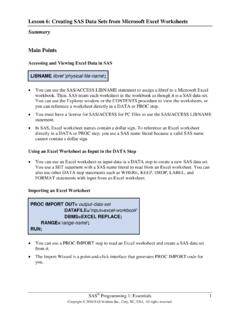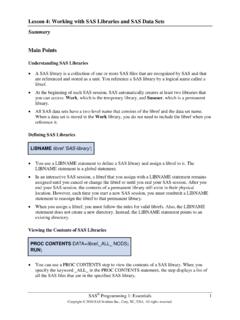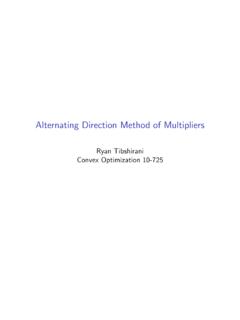Transcription of SAS Code to Select the Best Multiple Linear Regression ...
1 Paper SA01_05 SAS Code to Select the Best Multiple Linear Regression model for multivariate data using information criteria Dennis J. Beal, Science Applications International Corporation, Oak ridge , TN ABSTRACT Multiple Linear Regression is a standard statistical tool that regresses p independent variables against a single dependent variable. The objective is to find a Linear model that best predicts the dependent variable from the independent variables. information criteria uses the covariance matrix and the number of parameters in a model to calculate a statistic that summarizes the information represented by the model by balancing a trade-off between a lack of fit term and a penalty term. SAS calculates Akaike s information criteria (AIC) for every possible 2p models for p 10 independent variables. AIC estimates a measure of the difference between a given model and the true model .
2 The model with the smallest AIC among all competing models is deemed the best model . This paper provides SAS code that can be used to simultaneously evaluate up to 1024 models to determine the best subset of variables that minimizes the information criteria among all possible subsets. Simulated multivariate data are used to compare the performance of AIC to Select the true model with standard statistical techniques such as minimizing RMSE, forward selection, backward elimination, and stepwise Regression . This paper is for intermediate SAS users of SAS/STAT who understand multivariate data analysis. Key words: Akaike s information criteria , multivariate Linear Regression , model selection INTRODUCTION Multiple Linear Regression is one of the statistical tools used for discovering relationships between variables. It is used to find the Linear model that best predicts the dependent variable from the independent variables.
3 A data set with p independent variables has 2p possible subset models to consider since each of the p variables is either included or excluded from the model , not counting interaction terms. model diagnostics are calculated for each model to help determine which model is best . These model diagnostics include the root mean square error (RMSE) and the coefficient of determination (R2). A good Linear model will have a low RMSE and a high R2 close to 1. However, these model diagnostics alone are insufficient to determine the best model . The usual techniques taught in statistics courses to find the best Linear model include minimizing the RMSE, maximizing R2, forward selection, backward elimination and stepwise Regression . This paper will compare these techniques to minimizing the information criteria statistic on simulated data from several distributions. SAS code for determining the best Linear model will be shown.
4 COMMON STATISTICAL TECHNIQUES Five common statistical techniques taught in most statistics courses to determine the best Linear model include minimizing the RMSE, maximizing R2, forward selection, backward elimination and stepwise Regression . The RMSE is a function of the sum of squared errors (SSE), number of observations n and the number of parameters p and is shown in Eqn. (1). pnSSERMSE (1) The RMSE is calculated for all possible subset models. using this technique, the model with the smallest RMSE is declared the best Linear model . This approach does include the number of parameters in the model ; so additional parameters will decrease both the numerator and denominator. The coefficient of determination R2 is the percentage of the variability of the dependent variable that is explained by the variation of the independent variables.
5 Therefore, the R2 value ranges from 0 to 1. R2 is a function of the total sum of squares (SST) and the SSE and is shown in Eqn. (2). SSTSSER 12 (2) The R2 is calculated for all possible subset models. using this technique, the model with the largest R2 is declared the best Linear model . However, this technique has several disadvantages. First, the R2 increases with each variable included in the model . Therefore, this approach encourages including all variables in the best model although some variables may not significantly contribute to the model . This approach also contradicts the principal of parsimony that encourages as few parameters in a model as possible. Forward selection begins with only the intercept term in the model . For each of the independent variables the F statistic is calculated to determine each variable s contribution to the model . The variable with the smallest p-value below a specified cutoff value ( , ) indicating statistical significance is kept in the model .
6 The model is rerun keeping this variable and recalculating F statistics on the remaining p-1 independent variables. This process continues until no remaining variables have F statistic p-values below the specified . Once a variable is in the model , it remains in the model . Backward elimination begins by including all variables in the model and calculating F statistics for each variable. The variable with the largest p-value exceeding the specified cutoff value is then removed from the model . This process continues until no remaining variables have F statistic p-values above the specified . Once a variable is removed from the model , it cannot be added to the model again. Stepwise Regression is a modification of the forward selection technique in that variables already in the model do not necessarily stay there. As in the forward selection technique, variables are added one at a time to the model , as long as the F statistic p-value is below the specified.
7 After a variable is added, however, the stepwise technique evaluates all of the variables already included in the model and removes any variable that has an insignificant F statistic p-value exceeding the specified . Only after this check is made and the identified variables have been removed can another variable be added to the model . The stepwise process ends when none of the variables excluded from the model has an F statistic significant at the specified and every variable included in the model is significant at the specified . Other model selection techniques not evaluated in this paper include adjusted R2 and Mallow s Cp. Hocking (1976) and Sclove (1987) discuss the use of these and other statistical techniques in model selection. information criteria information criteria is a measure of goodness of fit or uncertainty for the range of values of the data . In the context of Multiple Linear Regression , information criteria measures the difference between a given model and the true underlying model .
8 Akaike (1973) introduced the concept of information criteria as a tool for optimal model selection. Akaike s information criteria (AIC) is a function of the number of observations n, the SSE and the number of parameters p, as shown in Eqn. (3). pnSSEnAIC2ln (3) The first term in Eqn. (3) is a measure of the model lack of fit while the second term is a penalty term for additional parameters in the model . Therefore, as the number of parameters p included in the model increases, the lack of fit term decreases while the penalty term increases. Conversely, as variables are dropped from the model the lack of fit term increases while the penalty term decreases. The model with the smallest AIC is deemed the best model since it minimizes the difference from the given model to the true model . Akaike (1973) forms the basis for the concept of information criteria .
9 Other references that use AIC for model selection include Akaike (1987), Bozdogan (1987 and 2000) and Sawa (1978). EXAMPLE data A multivariate data set with 10 independent variables and one dependent variable was simulated from a known true model that is a Linear function of a subset of the independent variables. The following SAS code simulates 1000 observations for these 10 independent X variables and one dependent Y variable. The 10 independent X variables come from normal, lognormal, exponential and uniform distributions with various means and variances. Variables X5, X6 and X9 are correlated with other variables. data a; do i = 1 to 1000; x1 = 10 + 5*rannor(0); * Normal(10, 25); x2 = exp(3*rannor(0)); * lognormal; x3 = 5 + 10*ranuni(0); * uniform; x4 = 100 + 50*rannor(0); * Normal(100, 2500); x5 = x1 + 3*rannor(0); * normal bimodal; x6 = 2*x2 + ranexp(0); * lognormal and exponential mixture; x7 = *exp(4*rannor(0)); * lognormal; x8 = 10 + 8*ranuni(0); * uniform; x9 = x2 + x8 + 2*rannor(0); * lognormal, uniform and normal mix; x10 = 200 + 90*rannor(0); * normal(200, 8100); y = 3*x2 - 4*x8 + 5*x9 + 3*rannor(0); * true model with no intercept term; output; end; SAS CODE FOR AIC The following SAS code from SAS/STAT computes AIC for all possible subsets of Multiple Regression models for main effects.
10 The selection=adjrsq option specifies the adjusted R2 method will be used to Select the model , although other selection options may also be used such as selection=rsquare. The SSE option displays the sum of squared errors for each model , while the AIC option displays the AIC statistic for each model . The first proc reg calculates AIC for all possible subsets of main effects using an intercept term. The second proc reg calculates AIC for all possible subsets of main effects without an intercept term by specifying the noint option. The output data sets est and est0 are combined, sorted and printed from smallest AIC to largest. The model with the smallest AIC value is deemed the best model . The SAS code presented in this paper uses the SAS System for personal computers version (TS level 02M0) running on a Windows 2000 platform. proc reg data =a outest=est; model y=x1 x2 x3 x4 x5 x6 x7 x8 x9 x10 / selection=adjrsq sse aic ; output out=out p=p r=r; run; quit; proc reg data =a outest=est0; model y=x1 x2 x3 x4 x5 x6 x7 x8 x9 x10 / noint selection=adjrsq sse aic ; output out=out0 p=p r=r; run; quit; data estout; set est est0; run; proc sort data =estout; by _aic_; proc print data =estout(obs=8); run; COMPARISON OF AIC RESULTS WITH HEURISTIC METHODS SAS will calculate the AIC for every possible subset of variables for models with up to 10 independent variables.
